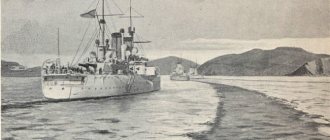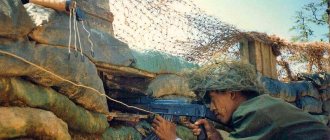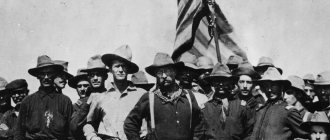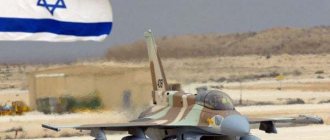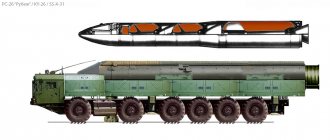Yom Kippur War [↑]
The fourth war (after the War of Independence of 1947-1949, the Sinai Campaign of 1956-1957 and the Six-Day War of 1967) between Israel and the Arab countries, lasting from October 6 to October 24, 1973. The war was named after the day on which it began: Yom Kippur is the Day of Atonement, which Jews around the world spend in fasting and prayer. On this day in 1973, Saturday, the armies of Syria and Egypt unexpectedly attacked Israel from two fronts simultaneously. After 18 days of bloody fighting, the war ended in Israeli victory.
Results of the war
However, a day later, the Syrian offensive in the northern Golan was stopped after a two-day battle in the Valley of Tears, and in the south the Israelis were eventually able to rectify the situation. The Israeli superiority proved too great, and the Arabs were unable to build on their initial success. But the decisive factor was US intervention. Golda Mair constantly called Washington day and night, humiliatingly begging big brother for help, claiming that Israel was on the verge of complete collapse. As a result, Washington began to put pressure on Arab countries, threatening them with direct intervention in the war. At the same time, the United States hastily began supplying weapons to its ally - Israel received from the United States one hundred and twenty-eight combat aircraft, one hundred and fifty M60 tanks, two thousand new-style ATGMs, many missiles and cluster bombs. A total of twenty-seven thousand tons of military cargo delivered by transport aircraft. As a result, the Arabs were thrown back to their original positions. Success came at a considerable cost to the Israelis - an Israeli veteran of this war recalled: “The most difficult thing was after the war. There were huge losses in our battalion, seventy percent killed and wounded. One guy and I went around the battle sites and extracted the remains of the guys from the tanks. They didn’t want anyone to remain nameless... But death in a tank... All that remains from a burnt person is a half-kilogram lump of yellow mass, similar to plasticine. You take it, break it, look for the soldier’s medallion... Every family has questions, questions... You begin to answer, and in their eyes: he died, and you are alive. And I couldn’t say everything to the end. Let's say there were cases when our soldiers were covered by their own artillery. How do you tell a mother that her child was killed by an Israeli shell?” Despite the fact that the Israelis eventually recaptured Suez, Egypt could consider this war a success - as a result of diplomatic negotiations (some time after the war), Israel was forced to return Sinai to Egypt. But Syria was ultimately left with nothing. The Israelis drew conclusions from the failed operation, and the next major attack on Syrian air defense (during the Lebanese war) was carried out flawlessly.
Background and reasons [↑]
Despite the 1970 treaty between Israel and Egypt, concluded under US pressure, it was clear that the Arab-Israeli conflict was far from being finally resolved. Israel's amazing victory over the united army of the Arab states in the Six-Day War and the capture of the Sinai Peninsula, the Golan Heights, parts of Jerusalem and the territories in the center of the Country were a heavy blow to the pride of the people of these states. Not wanting to admit defeat, Egypt, a month after the conclusion of the ceasefire agreement in 1967, began shelling Israeli territories in order to paralyze the lives of the civilian population and undermine the morale of the Israeli army. The intense shelling of Israeli territories and sabotage attacks by terrorists from 1967 to 1970 would later be called the “War of Attrition.”
Almost immediately after the end of the Six-Day War, the USSR resumed supplies of improved military equipment to both Egypt and Syria. In a short period of time, the Egyptian and Syrian armies not only replaced the losses suffered during the Six-Day War, but also significantly increased their military power. Enormous assistance from the USSR, as well as domestic and foreign policy pressure pushed the new President of Egypt, Anwar Sadat, to take revenge and return the territories that belonged to Egypt before the war. For several years, Egyptian and Syrian units, under the leadership of Soviet military advisers and instructors, planned an attack on Israel and conducted exercises to break through the lines of Israeli fortifications. The war was prepared long and carefully. The basis of the Arab strategic plan was to be the effect of surprise. To achieve this, preparations for war were carefully hidden, and a number of measures were taken to confuse Israeli intelligence. Yom Kippur was chosen for the attack, when life in Israel almost completely comes to a standstill.
Stages
The Six-Day War in the Middle East, due to its short duration, has no periodization. The Arab-Israeli conflict is examined briefly, day by day, with the classic beginning-development-end pattern. They also pay attention to several different fronts of the seven-day confrontation - Sinai, Jordan and Syria.
Start of hostilities (June 5, 1967)
The direction of airstrikes on the first day of the war
An analysis of the Six-Day War shows that the defeat of the Arab states was predetermined already in the first hours of the conflict. If all the troops attacked Israel from all sides at once, the state would not be able to resist the invasion on all sectors of the front.
The uncoordinated actions of the allies allowed Israel to immediately seize the initiative and show the whole world an example of modern blitzkrieg. The war began early on the morning of June 5th with Operation Moked. Israeli aircraft attacked Egyptian air bases, destroying most of the enemy aircraft with almost no losses.
The suddenness of the strike was ensured by several factors:
- complete secrecy - aircraft pilots learned about the operation 5 hours before it took place;
- unexpected timing - usually air raids are carried out before dawn, but the Israelis attacked twice at 7:45 and at 10:00, when vigilance and security at air bases were weakened;
- attack vector - the Israeli Air Force came from the north and west, which came as a surprise to the Egyptians, who were expecting raids from Israel;
- tactical preparation - the attack was perfectly coordinated, the first strikes were carried out on the runways, preventing enemy aircraft from taking off; almost all Israeli aircraft took part in the raid.
At about 11 a.m., Israeli territory was attacked by the Syrian and Jordanian air forces. At 12:45 a retaliatory strike was launched against these countries. Its result was the almost complete destruction of Allied air power and Israeli air supremacy. It was this aspect that predetermined the course of the subsequent war.
On the Sinai front, the Israeli group was reinforced with a mechanized brigade and three tank divisions. The offensive on the Sinai Peninsula began.
On the Jordan front, Israel sought to avoid active operations while operations were underway in Sinai. The King of Jordan was offered to remain neutral, but pressure from other Arab states dragged him into the war. The Israeli military was tasked with taking control of East Jerusalem.
On the Syrian front, the sides avoided active actions; there was mutual artillery shelling of positions. Having lost two-thirds of their air force, Syrian forces chose to hold the Golan Heights without attempting to advance further.
Development of the conflict (6-8 June 1967)
Advancement of tank units across the Sinai Peninsula
On June 6-8, on the Sinai front, Israeli tank units carried out a successful offensive against Egyptian positions. The latter, demoralized by the air attack and the loss of aviation, are forced to retreat. The landing force captures Sharm el-Sheikh, individual Egyptian units remain isolated, but the Sinai Peninsula is captured by Israel, after which its troops reach the Suez Canal.
On the Jordanian front, the Israelis surround Jerusalem. Despite stubborn resistance, on June 7, the Old City was taken by daylight assault, Bethlehem was captured by noon, and later Gush Etzion. At 20:00 on the same day, the parties accept the proposal of the UN Security Council and cease hostilities.
Trench warfare continues on the Syrian front until June 8. Neither side made any attempts to launch an offensive, limiting itself to artillery shelling.
Completion and Armistice (9–10 June 1967)
After the battle on the Golan Heights,
a ceasefire agreement was reached on the Jordanian front on the evening of June 7. The conflict in the Sinai Peninsula, at the proposal of the UN Security Council, was ended on June 9 by Israel, and by Egypt only the next day.
On the Syrian front, on June 9, the Israelis launched an offensive through Dan Banias along the foot of Mount Hermon. By nightfall, the Syrian defenses in this area were broken through. At the same time, an additional attack was organized on the Golan Heights south of Lake Kinaret.
The gradual advance of troops was intensified by the transfer of reinforcements from the Jordanian front. On June 10, Israeli troops approached the key offensive target, Quneitra, from different directions. By evening the city was captured. At 19:30 the parties agreed on a ceasefire.
Omissions of the Israeli command [↑]
On the eve of the war, Israeli intelligence notified the command of an unprecedented concentration of large army units on the borders - near the Golan Heights and the Suez Canal. Information was also transmitted about the hasty evacuation of the families of Soviet officials from Syria, which indicated an impending invasion. However, the intelligence reports were not properly received by the leadership; the facts were not correctly interpreted. The enemy's power was also misjudged. According to Chief of the General Staff D. Elazar, Israel should have launched a preemptive strike, since it was clear that war was inevitable. But the Israeli command not only failed to deliver an early strike, but also failed to mobilize reservists in a timely manner. As a result, the unexpected attack from Egypt and Syria caught the Israeli command by surprise, which led to heavy losses in the first days of the war.
The main reason for inaction and negligent attitude towards foreign intelligence reports is the euphoria of the Israelis and the feeling of their own invulnerability after the stunning victory in the Six-Day War. Already in the early days of the Yom Kippur War, it became clear to many that without supernatural intervention, victory in Israel's previous wars would have been impossible. After the war, a special commission was assembled under the leadership of the Chairman of the Supreme Court, Shimon Agranat, to investigate the reasons for the unpreparedness for war and the initial failures.
The Arabs are advancing
Preparations for war were also carried out by Syria, whose army was significantly strengthened (thanks to the same Soviet assistance). Therefore, the power with which the enemy attacked the line of fortifications along Suez on October 6 was completely unexpected for the Israelis. Eyewitnesses recalled a countless armada of Egyptian tanks stretching to the horizon, moving towards the Israelis. It was one of the most massive tank battles in world history. Thirty minutes after the start of the offensive, the Egyptians (having destroyed the firing points of the Israelis) occupied the first line of enemy defense. Their troops crossed the Suez Canal along its entire length. A jubilant Anwar Sadat (President of Egypt) called the Soviet Ambassador in Cairo Vladimir Vinogradov and shouted into the phone: “We have crossed the canal! We're on the east coast. Egyptian flag on the east bank! The Israelis counterattacked without delay, but this turned out to be an extremely reckless decision. Egyptian ATGM crews equipped with Soviet equipment managed to disable more than two hundred Israeli tanks on the first day. The glorious Israeli aviation suffered defeat after defeat, losing more than eighty aircraft in just three days. Israeli intelligence officer Yakov Kedmi later assessed the initial failure in the war this way: “One of the reasons for the first failures was the self-confidence of the leadership of our intelligence.” On the eve of the war, Moshe Dayan wanted to recommend Ariel Sharon for the post of chief of the General Staff, but although he had personal courage, he had absolutely no political courage. The Prime Minister vetoed, Dayan became shy and Arik left his post as commander of the southern district to his farm to graze sheep. Elazar, who was undoubtedly inferior to Sharon professionally, was made head of the General Staff. As an Israeli officer recalled: “in theory, everything was great with us, but in practice, not a single scenario from our general staff worked. There was a complete mess going on in the south. There was no strategic control, units entered the battle separately. People were thoughtlessly sent to certain death. Later, fabulous things became clear when, for example, the division was attacked by a tank battalion. And not because of tactical views, but only because of the stupidity of the leadership. Or the famous motto: “Not a step back.” And where is this? In the desert, where the nearest settlement is kilometers away. It was Ilochkov who had Moscow behind him, and our enemy did not even intend to walk across the sands, only to capture the entrances of the passes. Fortunately for the Israelis, the vast Sinai with its well-defended passes still lay between the Jewish state and Suez. The greatest danger was posed by the Syrian front, where two tank brigades tried to stop the large Syrian army.
Progress of the war [↑]
On Yom Kippur, October 6, at 14:00, Egypt and Syria simultaneously launch a massive attack on Israel's northern and southern borders, in violation of the peace treaty concluded in 1970. It was preceded and accompanied by heavy artillery fire. The Israeli garrison on Mount Hermon, a key strategic position, was destroyed by Syrian paratroopers flown in by helicopter.
At 14:15, a general mobilization of reservists throughout the country was announced. Military jeeps collected men of military age right at the exits of synagogues. Having taken off their tallit and changed their festive clothes to military uniforms, the reservists headed to assembly points, from where they were taken to the front.
The surprise of the attack bore fruit; for the first two days, success was on the side of the Egyptians and Syrians. By the morning of October 7, the advanced units of the Syrians reached the southern border of the Golan Heights. On the southern front, fortifications in the northern sector of the Bar-Leva line fell within a few hours of the start of the offensive.
The turning point came two days later, when mobilized reservists began to arrive at the battlefields. During fierce battles, the Syrians were completely driven out of the Golan Heights. On the Sinai front, the Israelis struck the junction of two Egyptian armies, crossed the Suez Canal (the old ceasefire line) and cut off the Egyptian 3rd Army from supplies. A UN ceasefire resolution soon followed.
By the end of hostilities, the Egyptian 3rd Army was encircled and cut off from sources of water and provisions. The IDF was only 100 km away. from Cairo, and Damascus could be fired upon by Israeli artillery from the front line, located 40 km away. From him.
October War of 1973
History knows many examples of how unwillingness to compromise, recklessness and political deafness led the warring parties to bloody tragedies that cast a shameful stain on the perpetrators of the conflict. A striking example of such behavior is the tragedy of October 6, 1973 - the day when the conflict that had been brewing for many years between two Middle Eastern states resulted in open military confrontation. It was on this day forty years ago, on the Jewish holiday of Yom Kippur, that the Egyptian armed forces, together with the Syrian military, suddenly attacked a relaxed Israel. This clash lasted eighteen days and was the fourth large-scale Arab-Israeli conflict, called the Yom Kippur War.
The military offensive on Israeli territory was initiated by two Middle Eastern states: Egypt and Syria. Diplomats from these countries have repeatedly tried to negotiate with the Israeli authorities on the issue of returning the lands seized back in 1967. However, Israel categorically rejected proposals from its neighbors, forcing the Arabs to take extreme measures and sign the so-called “rule of three nos,” which implies refusal of negotiations, recognition and peace with the Jewish state. This marked the beginning of a low-intensity political conflict that would go down in history as a “war of attrition.” The return of the lands once taken away became a matter of principle for the Arabs, a belated desire to wash off the dishonor received in the previous “Six-Day War.”
Having won a fairly quick and convincing victory in the 1967 war, Israel was absolutely confident that the Arabs, who, in their opinion, did not know how to really fight, would not dare to attack them in the coming decades. Along the Suez Canal, the Israelis built powerful fortifications called the Bar-Lev Line (on behalf of their developer, General Haim Bar-Lev). They consisted of several defense lines ranging in depth from thirty to fifty kilometers. The first strip ran along the Suez Canal and included a twenty-meter-high anti-tank rampart (about one hundred and sixty kilometers long) with platoon strong points equipped on the ridge. Each infantry platoon supported a tank platoon. Pipelines were located inside the shaft to ensure the flow of oil into the canal. In a critical situation, it was supposed to be released and set on fire. Between the defense lines there was a road patrolled by groups of tanks and motorized infantry. The road was intended to transport a battery of self-propelled guns to a threatened area. The basis of the second line were company strong points, which, according to calculations, were capable of holding autonomously for more than five days. And finally, thirty kilometers from the canal there were three armored brigades in reserve. The construction of the Bar-Lev line cost Israel three hundred million dollars. A defensive line seventy-five kilometers long was also erected on the Golan Heights (Syrian front). The basis was made up of strongholds located at heights, which included tanks dug into the ground (about twelve units per kilometer of front). There was also a canal at the heights - a ditch six meters wide and four meters deep. In both Syria and Suez, the Israelis were preparing for a defensive war, and the success of mechanized units in previous battles on the peninsula led their commanders to overestimate the importance of tanks and underestimate infantry and artillery. These mistakes had to be paid for in blood.
Egypt's desire, which originated back in 1967, to return the Sinai Peninsula and Golan Heights occupied by its neighbor and restore territorial integrity, acquired paramount importance after his successor Anwar Sadat came to power in Egypt in the fall of 1970 after the death of President Gamal Abdel Nasser. Taking into account the mistakes they had made, the Egyptians did a great job of building up and strengthening their combat power, as well as developing a new military strategy. Preparations for the future offensive were begun by Arabs thirsty for revenge back in 1971, when special training camps were built near Alexandria and Cairo, where the mobilized Egyptian armed forces practiced practical skills in conducting combat operations in the conditions of crossing the canal and overcoming heights in hilly terrain.
The number of engineer units in the Egyptian armed forces has increased. Particular attention was paid to the delivery of equipment to the bridgehead - pulling heavy vehicles in and out of the shaft is a slow and not the most pleasant task. In addition, the Egyptians decided to use an unusual approach to solve the problem of moving heavy equipment through sand banks that got in the way. During the summer of 1973, they purchased about one hundred and sixty water cannons - water cannons - from Germany and England. The idea was simple and ingenious: instead of overcoming the obstacle over the top, it was decided to use water cannons to erode the passages in the loose sandy banks.
The next step was to involve another disgruntled neighbor, Syria, in attacking the offenders. To divert the attention and forces of the Israelis, it had to begin military operations from the Golan Heights, and Israel's waging war on two directions at once could significantly increase the Egyptians' chances of victory. According to some sources, an additional impetus for the entry of this Arab state into the war was the attack by Israeli aircraft on Syrian MIGs on September 13, 1973. The air clash, in which twelve Syrian aircraft were shot down by the Israelis, took place over the Lebanese-Syrian border.
One of the lessons learned from the Six-Day War was the massive rearmament of the armies of Syria and Egypt. A huge contribution to equipping them with more modern military equipment was made by the USSR, which supplied Egypt not only with its tanks of various modifications, but also with experienced instructors who trained soldiers in the correct conduct of combat using armored vehicles. The Arabs equipped their army with a large number of Malyutka ATGMs, which were capable of quickly and effectively destroying enemy equipment. Periodically conducted exercises, which initially alarmed Israeli intelligence and border guards, eventually began to be perceived by neighbors as the norm.
The Arabs approached the issue of choosing the day of the offensive no less carefully, which became one of the main Jewish holidays, Yom Kippur (Day of Atonement). They knew that Israelis spend Judgment Day in prayer, and cities seem to be dying out: institutions and public transport do not work, and radio and television suspend their broadcasts. However, the cunning enemy did not take into account the fact that it was precisely the lack of traffic congestion that allowed the Israelis to ultimately mobilize quickly and receive reinforcements soon after the start of the offensive.
To call the attack by the Egyptians and Syrians a surprise would not be entirely correct, because it is known for certain that mobilization was announced in Israel early in the morning, long before the invasion began. Some members of the Israeli government had been demanding the adoption of urgent measures for a long time, and regularly received intelligence information about the impending offensive worried all the ruling circles of this country. However, the uncertainty and indecisiveness of Prime Minister Golda Meir, who was under pressure from the US Secretary of State, as well as the skepticism of then Defense Minister Moshe Dayan, ultimately proved decisive.
What was unexpected for the Israeli military was the power with which the enemy attacked the territory they held in Sinai on October 6. Describing the tank battles of the Fourth Arab-Israeli War, many historians compare them with such grandiose historical events as the Battle of Kursk in World War II. Eyewitnesses of the battles recall a countless armada of Egyptian tanks stretching to the horizon, moving towards the Israelis. The ground was constantly shaking from the explosions of artillery shells. It was one of the most massive tank battles in world history. At exactly 14:00, an air raid was carried out on the Israeli position, and five minutes later, Egyptian artillery struck a crushing blow, in which more than two thousand guns and mortars took part. The preparedness of the offensive is eloquently evidenced by the fact that in just twenty minutes the Egyptians had already disabled all the firing points of the Israeli defense, and after another ten minutes they were at the top of the rampart, transferring the fire deep into the defense. Their troops crossed the entire length of the Suez Canal, while simultaneously preparing passages for equipment in seventy pre-designated places. After lunch, a jubilant Anwar Sadat called the Soviet Ambassador in Cairo, Vladimir Vinogradov, and shouted into the phone: “We have crossed the canal! We're on the east coast. Egyptian flag on the east bank!
Fighting on the Sinai front from October 6 to 15
Fighting on the Sinai front from October 15 to 24
Fighting on the Syrian front
Here and below are excerpts from the memoirs of the October War by one of the most prominent representatives of the Israeli foreign policy services, Yakov Kedmi: “One of the reasons for the first failures is the self-confidence of the leadership of our intelligence. On the eve of the war, Moshe Dayan wanted to recommend Ariel Sharon for the post of chief of the General Staff, but although he had personal courage, he had absolutely no political courage. The Prime Minister vetoed, Dayan became shy and Arik left his post as commander of the southern district to his farm to graze sheep. Elazar was made head of the General Staff, who was undoubtedly inferior to Sharon professionally.”
Although the Israelis were discouraged by the unexpected pressure of the enemy, the speed and scale of the offensive, their reaction was not long in coming. As soon as the first Egyptian soldiers set foot on Israeli soil, they were immediately attacked by tank units. Due to lack of time for preparation, they acted blindly, without intelligence data, which turned out to be an extremely reckless decision. As a result, by the end of the day, Egyptian ATGM crews, with infantry support, managed to disable more than two hundred Israeli tanks. The glorious Israeli aviation suffered defeat after defeat, losing more than eighty aircraft in just three days.
On the evening of October 7, two tank, one mechanized and five Egyptian infantry divisions were already in control of the Sinai territory. The number of infantrymen reached one hundred thousand people, tanks - more than eight hundred. At the same time, the Egyptian Second Army was advancing towards the Mediterranean coast, and the Third Army was attacking in the Suez area. The fighting continued even at night, and in this regard the Egyptians and Syrians had one important advantage. The fact is that the bulk of the Arab tank fleet was made up of Soviet T-55s, which had night vision devices with the ability to be controlled by the crew commander and directly by the gunner. This made it possible to successfully fire at enemy armored vehicles, which had a more difficult time - in Israeli tanks, only the driver could use night vision devices. In addition, the small size of the T-55 and high maneuverability due to its relatively low weight made them less vulnerable compared to the heavier and larger tanks of the Israelis. However, with their large size and weight, the tanks of the Israeli army provided more comfortable conditions for the work of their crews, had a greater angle of elevation and descent of the gun, two to three times more ammunition and fuel tank capacity, as well as more powerful engines. These factors subsequently played an important role in the outcome of that war.
“In theory, everything was great with us, but in practice, not a single scenario of the General Staff worked. It was believed that the personnel units should hold the line of defense for twenty-four hours until the reserve arrived, but they could not. There was a complete mess going on in the south. There was no strategic control, units entered the battle separately. People were thoughtlessly sent to certain death. Later, fabulous things became clear when, for example, the division was attacked by a tank battalion. And not because of tactical views, but only because of the stupidity of the leadership. Or the famous motto: “Not a step back.” And where is this? In the desert, where the nearest settlement is kilometers away. It was Klochkov who had Moscow behind him, and our enemy did not even intend to walk across the sands, only to capture the entrances of the passes. Instead of withdrawing troops, maneuvering to lure the Egyptians out from under air cover and destroy them, our leadership ordered to hold the desert. All this ultimately led to great casualties.”
The successes of the Arabs in the Sinai direction were more than offset by the failures of the Syrians in the Golan Heights region. Two days after the first attack, the Israelis came to their senses and on October 8 moved on to decisive military action, beating the Syrians quite hard. Until October 14, the Israeli army managed to significantly advance in the direction of Damascus and firmly gain a foothold in the recaptured positions, so as not to stretch communications.
In Sinai, throughout October 8, a fierce tank battle continued, in which Israeli tank brigades lost up to sixty percent of their equipment. In one of the desperate attempts to break through the Arab defenses, the Israeli brigade managed to lose twenty-four tanks in eighteen minutes. It was also significant that almost half of the armored vehicles were destroyed by Egyptian helicopters armed with ATGMs, and the Israeli squadron, which was always considered “invincible,” could not help in any way, since the Egyptian air defense forces worked flawlessly. On October 9, the Egyptian army managed to completely destroy the 190th Israeli tank brigade, and its commander, Asaf Yaguri, was captured.
On October 10, after four days of intense battles, the situation on the battlefield stabilized a little and there was a slight respite. From time to time, the Israelis launched minor counterattacks on Egyptian gun emplacements. The calm could be explained very simply: both sides of the military conflict were awaiting the arrival of reinforcements from their sponsors, which for the Israelis was the United States, and for Egypt and Syria - the USSR. The Israelis preferred not to take risks, their position was already very precarious, and any enemy offensive could end in a breakthrough of the defense, opening the way to the north for the Arabs.
Activity on the Sinai front resumed at 6:30 a.m. on October 14, when four Egyptian infantry and two armored divisions attacked the enemy sharply and advanced ten kilometers forward on the move. However, then the Arabs attacked two hundred entrenched Israeli tanks. With the support of eighteen helicopters equipped with TOW anti-tank systems, the Israelis managed to destroy almost half of the advancing Egyptian tank brigade near the Mitla Pass. Then, in the ensuing night battle, they destroyed another two hundred and sixty tanks and two hundred armored personnel carriers of the Egyptians. The Israeli army's own losses amounted to a little more than forty tanks. On the same day, General Mendler, who commanded the Israeli armored units in the Sinai, died.
“In the first air battles we lost our best pilots. Another miscalculation of our leadership: an attack on the Egyptian army with working air defense systems. They shot at planes at point-blank range, more than a hundred were shot down. In general, the Egyptians fought very courageously. Their professional level was not very good, the leadership also had problems, and the higher, the more, but the ordinary soldiers fought desperately. I remember how we moved three times alone. He stood opposite the tank and sprayed us with a Kalashnikov. We drove at him, and he lay down between the tracks, then got up and shot again. We turned the car around and faced him again head-on... As a result, when he lay under the tracks for the third time, we turned the tank on the spot.”
The losses of both sides grew so much that it was no longer possible to do without additional supplies of weapons and equipment from interested “benefactors.” To be frank, if it were not for US assistance, it is unlikely that the outcome of the October War would have been so favorable for Israel. In those days, European countries completely refused the country military assistance. Golda Meir continuously called Washington day and night and asked to arrange a meeting with the President of America and an air bridge. Her set of phrases sounded something like this: “Help us today. Tomorrow will be too late." At the same time, the prime minister constantly reminded the Americans that “huge deliveries of Russian weapons” were being made to Syria and Egypt. Ultimately, Nixon gave permission and the air bridge came into being on October 14, the ninth day of fighting. Upon hearing that the first military transport plane had landed at the airport, Golda Meir, by her own admission, burst into tears of happiness. There really was something to be happy about - the distant allies did not skimp on tanks, shells and missiles (especially air-to-air). Over the next ten days, Israel received from the United States one hundred and twenty-eight combat aircraft, one hundred and fifty M60 tanks, two thousand advanced ATGMs, many missiles and cluster bombs. Twenty-seven thousand tons of military cargo were delivered.
On October 14, a group of Israeli saboteurs disabled the Egyptian radio interception center in the Jebel Ataka area. This loss greatly complicated the latter’s command and control of troops and conducting reconnaissance. On October 15, the Israelis launched their first frontal counterattacks with nine tank brigades. And although intense fighting continued throughout the day, none of the warring parties succeeded.
One of the most talented Israeli military leaders, Major General Ariel Sharon, found a non-standard and unexpected way out of the situation. An excellent student of political and combat training during the old Arab-Israeli wars, he was hastily pulled out of the reserves. It is difficult to say today what inspired Sharon when developing his plan - a specific historical example or the general hopelessness of the situation, supported by an unclear high command. It is only known that he previously vehemently criticized the construction of the Bar-Lev Line, noting that the very similar Maginot Line did not help France in 1940.
Sharon decided to use a very adventurous technique - to strike with the 143rd Armored Division at the weakened junction of the second and third Egyptian armies, covering the Israeli positions. Interestingly, a little earlier Moshe Dayan ordered that the entire Southern District refrain from attacks. Stabilization of the front was necessary for the government ahead of likely ceasefire negotiations with the Egyptians. However, Ariel Sharon ignored this instruction.
On the night of October 15-16, 1973, a small Israeli detachment, which included seven tanks and eight armored personnel carriers, crossed the Great Bitter Lake, occupying a small bridgehead on the Egyptian shore. The enemy army allowed the Israeli movement to begin without allocating additional funds for the defense of the West Bank. It was thanks to the presence of an entrenched bridgehead on the enemy bank that Sharon’s units were able to build a pontoon bridge and transport tanks to the opposite bank.
“The Egyptians crossed the canal quickly and under fire. None of our means of forcing, prepared in great secrecy, worked. Only pontoons purchased in Germany... Our success was the result of a mistake by the Egyptian leadership, who decided that tanks would not go there. If they had left at least one brigade, then the whole story would have gone differently... Having captured a bridgehead on the opposite side of the Suez Canal, we reached the second echelon troops. Having transferred their anti-tank weapons to the first line, they were deprived of the means to combat armored vehicles. By the way, there was a funny story with air defense systems. The command ordered them to be disabled, but not to hit the missiles, but only the antennas. We eliminated the control system and antennas, but the family was not without it... One hit the rocket. Without control, it wrote sinusoids between the tanks for several minutes, then flew somewhere to the side, where it exploded. Then we covered this smart guy in all languages.”
When the Egyptians realized what their carelessness was threatening them with, they immediately attacked, trying to cut off the small enemy group that had settled on the western bank. But even air support and the power of tank and infantry divisions could not bring significant results. The Battle of Bitter Lake near the "Chinese Farm" was, according to some observers, the most fierce. The night battle ended very badly for the Egyptian army: Sharon’s troops managed to knock out up to one and a half hundred Egyptian tanks with personal losses of seventy vehicles. The next day, October 17, the Egyptians lost the same number of armored vehicles, while the Israeli army lost only eighty tanks. At the end of the day, the Egyptians made a last desperate attempt to push back the enemy, for which they paid with the loss of eighty-six vehicles, while the Israelis lost only four units of equipment.
On October 18, the 252nd and 162nd Israeli divisions, having crossed to the other side of the canal, began to enter the rear of the main group of Egyptian troops represented by the third army. One of the first and most important losses of the Egyptians was the virtual complete destruction of their air defense forces stationed west of the canal. And this, in turn, opened the skies for Israeli aviation. On October 19, the position of the third army turned from dominant to threatened. The Israeli army was preparing to deliver a decisive blow to its hated neighbor, but at that moment the UN decided to intervene in relations between Middle Eastern countries, demanding an immediate cessation of hostilities. Both sides used the short lull to take a breath and regroup their forces, preparing for new battles. The Israeli army was in no hurry to follow the advice of the “big brothers” and stopped only on October 25 after the capture of Suez, which became the last chord of the battle in Sinai. Three days of psychological pressure on the ruling circles of Tel Aviv with the demonstrative bringing of the US nuclear forces and Soviet airborne forces to full combat readiness bore fruit. The war was stopped.
“The most difficult thing was after the war. There were huge losses in our battalion, seventy percent killed and wounded. One guy and I went around the battle sites and extracted the remains of the guys from the tanks. They didn’t want anyone to remain nameless... But death in a tank... All that remains from a burnt person is a half-kilogram lump of yellow mass, similar to plasticine. You take it, break it, look for the soldier’s medallion... Every family has questions, questions... You begin to answer, and in their eyes: he died, and you are alive. And I couldn’t say everything to the end. Let's say there were cases when our soldiers were covered by their own artillery. How do you tell a mother that her child was killed by an Israeli shell?”
All participants in the war suffered noticeable losses: in nineteen days of fighting, the Arab states lost three hundred and sixty-eight helicopters and airplanes (and sixty-nine of them were shot down by “their” air defense forces due to errors and misunderstandings), and one thousand seven hundred units of armored vehicles. More than eighteen thousand people were killed and about fifty thousand were injured. Israel lost one hundred and fourteen helicopters and planes, more than eight hundred armored vehicles and tanks. About two and a half thousand Israelis were killed and seven and a half thousand were wounded.
Until now, researchers from different countries have not come to the same opinion on the issue of assessing the results of the war. Arab countries believe that they won in 1973, destroying the myth of the invulnerability of the Israeli army. In Egypt, October 6 is generally celebrated as Victory Day. As evidence, they argue that only after the war did Israel agree to negotiations, which resulted in the liberation of the Sinai Peninsula. In Israel, on the contrary, they believe that they won, and it is difficult to argue with this: eighteen days later, the IDF found itself a hundred kilometers from Cairo, the third Egyptian army was surrounded, and Damascus lay in full view in front of the Israeli artillerymen. And yet, based on the goals that the warring parties set for themselves, none of them were fully achieved.
The Fourth Arab-Israeli War, according to most historians, ended in a “draw” with the exception of one positive aspect - the Israeli elite finally began seriously to improve its relations with the countries of the Middle East. After the end of hostilities in Israel, a commission was created, headed by the Chairman of the Israeli Supreme Court, Shimon Agranat. It was she who was tasked with understanding the reasons for the “misunderstanding” that had occurred, which almost developed into a national catastrophe. The preliminary findings of the commission, which were announced on April 1, 1974, shocked the public. According to its conclusion, the Israeli intelligence services were provided with cover in the form of ongoing exercises to reveal the true intentions of the Egyptian military, and the premature mobilization of forces was postponed so as not to provoke the Arabs into conflict.
“Senior leadership has been replaced, but the principles of command and army training remain the same. Instead of deep analysis, people fell into a state of euphoria. Everyone who took part in the battles, regardless of how they performed, was promoted to rank. There were many people in the professional army who, before the war, did not get into command courses due to inadequacy. Only special forces, Hi-Tech specialists, naval officers and pilots have retained a truly high professional level in our army.”
Four months after the end of the conflict, Golda Meir openly stated that the highest leadership circles in Israel had made serious mistakes that almost caused defeat. In response, the majority of the country's residents recognized it as the main culprit of the Yom Kippur War. Some time later, more precisely on April 11, 1974, at the peak of a wave of mass street protests, the prime minister was forced to leave her post, losing it to the former Israeli Ambassador to the United States Yitzhak Rabin, who during the more successful Six-Day War of 1967 commanded the General Staff Israeli army. In parting, she said: “I’ve had enough. I’ve been carrying this burden for five years, I don’t have any more strength.” The heads of the military also rolled: Chief of the General Staff David Elazar, commander of the entire Southern District Shmuel Gonen, as well as prominent military intelligence leaders resigned. The war hero Sharon also suffered, who virtually single-handedly saved the nation from defeat, since he headed the Southern District until the end of the summer of 1973. It was up to Yitzhak Rabin's successor, Menachem Begin, who was appointed Prime Minister of Israel in 1977, to implement the current policy of national reconciliation. The result of this policy was the signing of the Camp David Accords in 1979, which effectively marked the end of the Arab struggle with the Jewish state. The irony of history is that Begin made peace with Sadat on almost the same terms that Golda Meir rejected in 1971. The powerful slap of the “October War” once again proved to Israel and the whole world that pride is a very bad adviser in politics.
The October War becomes increasingly important as it fades into the past. In particular, it marked a new era of military conflicts in which various surface-to-air, surface-to-surface, sea-to-surface and air-to-ground missiles began to be widely used. In light of the data obtained, military strategists had to rethink all military technology and science. In addition, the Arab-Israeli war was the formal cause of the very first global oil crisis. On October 17, 1973, the main oil exporters from among the Arab countries decided to reduce its production and also impose an embargo on supplies to the United States. These measures have had a tremendous impact on the global economy.
Among the subjective factors, it is worth especially noting the foreign policy of Anwar Sadat, who began the transformation of Egypt from an ally of the USSR into a country hostile to us, open to cooperation with the United States. Soviet diplomats began to be pushed back from participating in the Middle East settlement processes, which were gradually taking on the character of bilateral agreements between Israel and Egypt under the patronage of Washington. In 1976, the first C-130 military transport aircraft from the United States arrived in Egypt. At the same time (March 14, 1976, to be precise), Sadat announced the termination of the treaty of friendship and cooperation with the USSR. Within one month, all Soviet military services left the country.
Sources of information: https://btvt.narod.ru/2/wsd.html https://ria.ru/analytics/20131006/967823621.html https://www.agentura.ru/dossier/izrail/nativ/kedmi / https://www.polit.ru/article/2008/10/08/war/
Outcome of the war [↑]
Although Israel was victorious, the Yom Kippur War was a traumatic experience. The number of Israeli deaths was so high that nationwide mourning was declared in the country. The losses of the Israel Defense Forces in this war were: 2,552 soldiers killed, about 7,500 wounded, 326 people were captured.
The Syrians lost about 3.5 thousand killed and about 1.2 thousand tanks; 370 Syrian soldiers were captured. Egyptian losses - about 15 thousand killed, 8 thousand prisoners and over a thousand tanks.
Victorious from a military point of view, politically this war was a defeat for Israel. Trying to put pressure on Israel, Arab states imposed an embargo on oil supplies to the United States and some Western European countries. Almost all African states have severed diplomatic relations with Israel. Foreign political pressure, a severe economic crisis, and isolation on the world stage negated the significance of this victory. This even affected the policies of the states of Western Europe and South America that are traditionally friendly to Israel. The current situation increased Israel's dependence on the United States, which was also trying to improve its relations with Arab countries. According to historian Dr. Meir Pail, a direct consequence of the war was Israel's concessions during the peace negotiations on December 21, 1973 in Geneva. Then Israel was forced to sign an agreement that placed it strategically in worse conditions than before the start of the war.
After the war, a commission was assembled to investigate the omissions of intelligence and command in the run-up to the war. Based on the results of the report, published on April 2, 1974, it was recommended to remove from office the Chief of the IDF General Staff, David Elazar, the head of the Aman military intelligence, General Eli Zeir, and his deputy, the head of intelligence of the Southern District, Lieutenant Colonel Gedalia, as well as Shmuel Gonen, the commander of the Southern Front. Popular discontent, especially discontent among former officers and war veterans, led to the resignation of Prime Minister Golda Meir. The entire cabinet followed her, including Moshe Dayan.
Target: Syrian air defense
The Israelis decided to turn the situation around with the help of their powerful aircraft. Therefore, four squadrons of “phantoms” were preparing for a long-planned operation to destroy enemy air defenses. This had to be done in one well-coordinated strike, so that later, without hindrance, the enemy could be defeated by the forces of bombers and attack aircraft. The first strike (carefully planned in advance) was supposed to be delivered to Egypt, but Moshe Dayan suddenly demanded that Benny Peled, the head of the Air Force, cancel the operation that had already begun against the Egyptians in order to crush the Syrians in the north. “Benny, leave everything you are doing in the south and transfer everyone to the Golan. We are facing a catastrophe,” he allegedly told Peled. And at Air Force headquarters they began to frantically change plans. The problem was that the planes of the first wave had already attacked the Egyptians, and all the support equipment, electronic warfare helicopters, aircraft with passive jamming equipment and Shrikes - all this was already on the Egyptian front. The Israelis began to improvise, moving forces against the Syrians. As a result, almost without preparation (but in conditions of complete chaos), Operation Dugman-5 began. The idea of the operation was simple: five squadrons of “phantoms” were supposed to turn the Syrian air defense forces into dust. The first wave was to attack with cluster bombs. The second is to break through at low altitude to the positions of Syrian anti-aircraft systems and finish them off. The problem is that the plan was based on intelligence data from the previous day, and the mobile anti-aircraft systems (naturally, Soviet-made) had already changed positions. Meanwhile, it so happened that the route of the “phantoms” was laid directly above the air defense centers of the Syrian mechanized divisions. But the Israelis did not know about this. As a result, the Israeli pilots discovered that the positions they were supposed to attack were empty, but the pilots themselves found themselves under heavy fire from Syrian air defense. The first to be shot down was the crew of Ehud Hankin and Shaul Levi. Almost immediately, on approaching the target, the Syrians shot down another “phantom”. Two more are above the target. And the same amount when returning. The failure was complete, since with heavy losses (six “phantoms” were shot down, six more were seriously damaged), only one division of the S-125 air defense system was destroyed. One of the Israeli planes landed in Hazor... without a navigator, who, panicking, ejected after a near rocket explosion and was captured. The Israeli plan to turn the tide of the war with air power failed.
Miracles during the war and their influence on the teshuva movement of the 70s [↑]
As in many other wars of the young Jewish state, miracles accompanied the soldiers and command at all stages of hostilities. After the end of the war, amazing stories began to leak into the media: many soldiers talked about how they survived only thanks to a miracle and Providence. As one war veteran once stated: “In principle, every survivor was saved to one degree or another thanks to a miracle.” In the general atmosphere of spiritual awakening of those days, a new wave of return to teshuva arose. Many war participants and former officers returned to the Torah and the commandments.
A short story vividly illustrating the miraculous events of those days was published in the media immediately after the end of the war: “On the day of Hoshana Rabba (the penultimate day of Sukkot), a private was ordered to deliver a truck with military equipment to the Southern Front. After several hours of travel, he noticed through the window a group of soldiers crowding around a Tsahal stronghold near the Suez Canal. The soldiers waited in line to hold the lulav, the only set for the entire garrison. The truck driver who was an absolute idiot
(“secular”, not religious), was surprised by this spectacle and, making sure that nothing except a religious ceremony was happening here, decided to move on. But after one of the participants in the “rite” explained to him that this was the last opportunity this year to fulfill the commandment of four types of plants, the soldier for some reason decided to do this, left the car further away and stood in line. After a long wait, when it was his turn and he took the lulav, there was a deafening explosion. There was a deep crater smoking where the truck had stood a moment ago. As it turned out, the truck was destroyed from the air by enemy forces. All the equipment in the vehicle was blown up, the metal parts were vaporized, and after the explosion there was nothing left of the truck. The driver had no chance to survive. Three months later, the soldier’s daughter was born. Since he miraculously escaped death - thanks to fulfilling the commandment of Lulav - he named his daughter the name Lulav.
Help from Diaspora Jews [↑]
The Yom Kippur War, like the Six Day War, sparked a wave of Jewish solidarity. During the hostilities, the volunteer movement intensified, providing effective assistance to Israel in various areas. Fundraising for Israel has reached unprecedented levels. Regular prayers were organized in the diaspora communities for the salvation of the soldiers and their victory. At the height of the war, the number of repatriates from the Soviet Union not only did not decrease, but even increased compared to previous weeks. The Yom Kippur War once again revealed the unity of the Jewish people and the ability of the Jewish Diaspora to provide assistance in times of great need.
SAM L2K12 "Cube"
Soviet anti-aircraft missile system for military air defense. Developed at OKB-15 GKAT (branch of NII-17; now - Research Institute of Instrument Engineering named after V.V. Tikhomirov). The technical characteristics of the "Cube" complex ensured the detection of air targets at ranges of up to 65 km and their firing at distances from 4.5 to 23.5 km and at altitudes up to 14,000 m. The main targets for the "Cube" air defense system were aircraft and cruise missiles with speeds up to 600 m/s (on a collision course). The latest modifications of the complex (“Kub-MZ”) ensured the firing of helicopter-type targets while hovering in the air.

